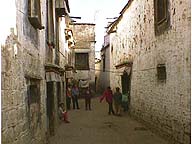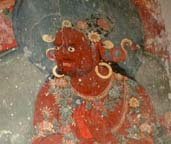Asianart.com | Associations | Contact Tibet Heritage Fund | Who is THF
Lhasa Map | Report 98 | Report 99 | The 76 Houses

| The Tibet Heritage Fund now has it's own site, where you can see latest updates and contact the fund. Please click here to go to: tibetheritagefund.org |

Lhasa Archive Project
The ancient centre of Lhasa...
Lhasa is one of the ancient historic cities of the world. It is also Tibet´s foremost holy city, centered around the Jokhang Temple founded in 641 AD. Another important historical site is the 17th-century Potala Palace (former winter palace of the Dalai Lamas). The Jokhang Temple is surrounded by a circular circambulation path known as the Barkor, a maze of narrow alleyways and low, white-washed houses built in stone. This area, 1.3 km2 in size, constitutes the historic inner city, a mere 3% of the total size of today´s modern city area.
The incorporation of Tibet into the People´s Republic of China in the 1950s has caused a serious transformation of traditional Tibetan society and lifestyle. The large scale destruction of cultural heritage in the 1960s has left much of Tibet in ruins. Since the early 1980s, attempts at restoration of important sites are permitted and sometimes state funded.
Lhasa has official status as one of the historic cities of China. But apart from the major monuments and temples, individual buildings and historic townscapes (alleyways, squares etc.) are not protected.
The phase of rapid urban (re-) development that started in Lhasa in the early 1990s has transformed most of the historic area. By mid-1997, only less than 200 authentic old buildings remained of the 600 buildings recorded in 1948. Many of the existing old houses are in serious dilapidation, caused by decades of neglect. Ongoing demolition presents an acute threat to the authencity of Lhasa as a living historic city.
Living standards in the old city are lower than in some of the new city areas. Both old and new public housing have only pit-model toilets, sewage system and water supply in the area need improvement.
Conservation Project
In a pilot project carried out in 1996, the Tibet Heritage Fund organized, funded and supervised the restoration of two ancient buildings on the Barkor, both originally scheduled for demolition. Traditional techniques and materials were revived, and old craftsmen, educated in the 1940s, were employed as consultants. The original tenants were guaranteed permission to continue living in the houses, and were involved in the restoration process.
It is now planned to carry out similar work in the one of the most important old neighbourhoods of old Lhasa, and to combine restoration with an environmental health programme, upgrading of facilities and more comunity involvement. The project activities planned for 1997 are part of a long-term strategy to develop a conservation plan for Lhasa.
Tibet Heritage Fund
1997 Programme ActivitiesIn 1997, the THF intends to continue the development of a Lhasa Historic Inner City Conservation Plan that includes:
- Creation of a Conservation Zone
- Carrying out restoration and rehabilitation of historic buildings
Conservation Zone in red
(click for full page)The Conservation Zone project hopes to preserve one still intact old neighbourhood. In this zone, all buildings should get official status as protected historic buildings. Over the next three to four years, buildings shall be repaired and water and sanitation facilities upgraded. The local community will be involved in the entire process, from planning to the actual work phase, and for maintenance afterwards.
Scenes from the Conservation Zone
(click on each picture for full screen)General aims of the Tibet Heritage Fund Programme:
- Protection of the inner city as a living historic area (halting the ongoing demolition of old houses)
- Preserving knowledge of traditional architecture, organising training programmes for traditional construction and restoration, enhancing local knowledge by introduction of international technical experience
- Protection of Tibetan art by running a wall- painting restoration training programme
- Upgrading the living conditions in the historic inner city
- Running an environmental health programme that includes safe water supply, solutions for sewage and solid waste disposal, and a hygiene education project
- Local community involvement in rehabilitation and maintenance projects
Latest Updates:
July 21, 2000: 1999 Annual Report, extensively illustrated, shows the progress of THF work in Lhasa and beyond for the year 1999.
May 01, 2000: 76 houses has been extensively updated with new information and photographs of many of the houses in the project. Many new individual house pages have been added.
May/June 1999: Report 98, a comprehensive report on the activities of the Tibet Heritage Fund, goes on-line. Includes the Lhasa Map of the 76 Houses, perhaps the best available guide to the activities of the THF in the Old City of Lhasa. Check again for further additions to the Map. Eventually every house being restored by the THF will have its own page.
Nov/Dec. 1998: Extension of program: Lho Talung Monastery
THF occasionally receives requests for help from different parts of Tibet. THF plans to extend its current program to provide financial and technical assistance to help preserve important historic monuments in parts of Tibet outside of Lhasa. This is because THF has received a number of urgent requests from local officials and communities, and also because THF views its Lhasa Old City Program as successful.
Projects in the countyside will be carried out only on local request, and follow the Lhasa program approach:
- 1 reviving traditional skills locally available
- 2 passing on new techniques for restoration
Thus, it is hoped that in more areas of Tibet important historic monuments and buildings can be preserved and rehabilitated ultimately through local efforts.
An example of this is Lho Talung Monastery:
Lho Taglung Monastery, old Lhakhang: morning Nov 15 1998:
photo: I. Alsop, Asianart.comThe local community, with support of the authorities, requested THF to visit Lho Talung, a Sakyapa monastery just south of Lake Yamdrok Tso. Lho Talung was reportedly founded as one of the Tamdul Yamdul monasteries by king Srongtsan Gampo in the 7th century, during the first diffusion of Buddhism in Tibet.
With transportation provided by the local community, THF made a first visit in September 1998.
The monastery's roof was taken off during the Cultural Revolution, and the wall paintings suffered consequently from leaking roofs. While some mural art has been lost during the cultural revolution, a lot of the damage to the murals happened during the unusually heavy summer rains of 1998.
Mahasiddha Virupa, Taglung, early 15h c.
photo I. Alsop, Asianart.comProfessor David Jackson, a leading expert on Tibetan religious art, made a preliminary dating of the Lho Talung murals using photos taken by THF. The murals are from the early to mid-1400s, and belong to the Gyantse school.
On the second visit, on November 14-15, 1998, a THF team consisting of John Harrison, volounterr Zara Thiessen and director Andre Alexander made a rough survey of the monastery. Unfortunately, the top layer of the wall on the surface of which the murals are painted is becoming detached from the rest of the wall, with the danger of the paintings one day falling off the wall.
THF is currently working on a plan to protect the paintings - at least temporarily - before the next rainy season.
Plaque showing protected status: Ongdue Khangsar (dbang 'dus khang gsar)
photo I. Alsop Asianart.com Nov. 1998June-December, 1998: In June 1998, THF achieved a major change in official preservation policy in Lhasa. The municipality created a new protected status for historic residential buildings in the old town. THF submitted a list of 76 buildings, which have now been listed. A blue plaque identifying each building and proclaiming it a protected building (in Chinese and Tibetan) has been affixed to each of the 76. More buildings will hopefully be listed next year.
Following this development, the THF has increased its activities. In 1998, THF has worked on 22 of the 76 protected buildings, carrying out full restoration, emergency repairs, and/or water and sanitation improvement. THF has also built a public toilet in traditional style, with the septic tank system, near the southern stretch of Barkor street.
Andre Alexander with a satisfied customer in front of the new public toilet built by THF
photo IA, Asianart.comAt present (December 1998), THF employs 100 local Tibetans. THF also carries out vocational training, with traditional and modern construction, carpentry, plumbing and electrical wiring being taught.
February 27, 1998: The Lhasa Archive Project releases its three part Map of Lhasa, titled Tibetan Old Buildings and Urban Development in Lhasa:
1948-1985-1998January 22, 1998: In 1997, the THF created the Barkor/Odepug conservation zone in Lhasa (see further details, Conservation plan, above). In this area, one of the oldest neighborhoods of Lhasa, the THF started a water-supply pilot project, in cooperation with the Lhasa Water Office, by upgrading the water supply for 16 houses. By installing new pipes and taps, with the local residents doing part of the work, the THF has helped to provide safe drinking water for the area. Restoration works on the historic buildings in the area has only just begun, and will continue during 1998. A toilet-upgrading pilot project is also planned for 1998.
The THF/L.A.P. proposal of placing the most important 25 historic secular buildings in Lhasa under permanent protection will also be followed-up in the coming months.
Asianart.com | Associations | Contact Tibet Heritage Fund | Who is THF
Lhasa Map | Report 98 | The 76 Houses








